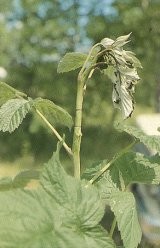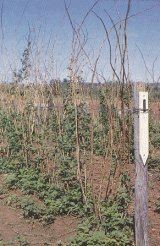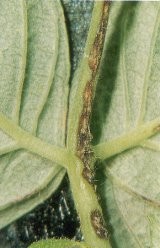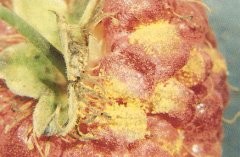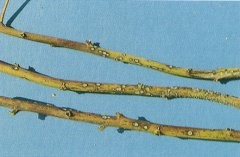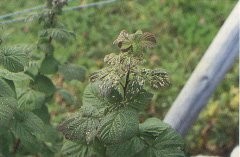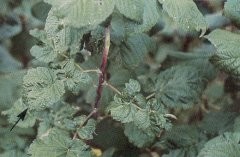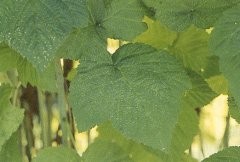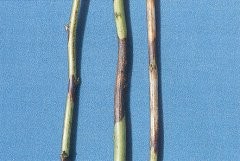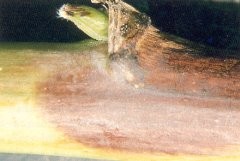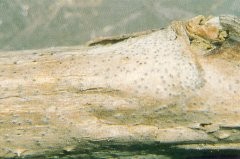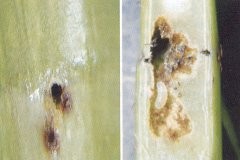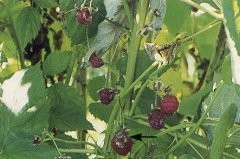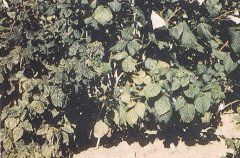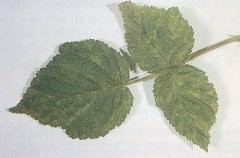Raspberry Cane Borer
The adult raspberry cane borer (Oberea bimaculata ) appears in June, and is a slender black beetle about 12.5 mm (1/2 inch) long. It can be recognized by the yellow band near its head and its prominent antennae. The beetle cuts 2 rings around the stem about 2.5 cm (I inch) apart and 10-20 cm (4-8 inches) below the shoot tip. An egg is laid between the rings and the top wilts and dies (Fig. 1). When the egg hatches the larva bores into the pith and feeds until it overwinters just below the point of girdling. The next season the larva bores down to the base of the cane and overwinters at or below ground level. Pupation occurs in the spring and the adults emerge. As only a few plants are usually attacked in any one year, control can be achieved by cutting off the affected canes below the point of girdling.
Winter Damage on Raspberry
Raspberry canes may be damaged during the winter in any of the following ways: snow breakage, tip dieback and topkill (Fig. 2). Snow breakage occurs from snow pushing down on or against the canes causing them to break. Control is best achieved by modifying or removing the obstacles (ie: hedges) which cause the snow to drift around the canes. In areas where tip dieback and topkill occur year after year, delay the heading back operation until the spring and cut off the dead areas of the canes in the process. All topkilled canes should also be removed at ground level at this time. Differences in susceptibility to winter damage exists between respberry varieties.
Anthracnose
Anthracnose, caused by the fungus Elsinoe veneta , can be identified by the small 3 mm (1/8 inch) grey spots with purple borders that appear on leaves, petioles (Fig. 3) and canes (Fig. 5). These become large irregular blotches when two or more spots grow together. As the disease progresses, infected tissue in the leaf often drops out leaving holes, lesions on canes become sunken and the bark frequently cracks. Small black bodies which contain spores, form in the grey area of these lesions in the fall and following spring. The spores are carried by splashing rain to infect other plants. For control see Spur Blight.
Late Yellow Rust
Late yellow rust, caused by the fungus Pucciniastrum americanum , is usually considered a minor problem in raspberries. However this disease can become quite severe on susceptible varieties such as Festival. The greatest losses from late yellow rust occurs when the yellow rust pustules develop on the fruit rendering it unmarketable (Fig. 4). The rust may also cause defoliation and stem cankers on infected plants Usually these symptoms develop following harves . The fungus cycles from raspberry to spruce and back to raspberry. Therefore removal of the spruce from the perimeter of the field may be beneficial in reducing the disease. Old canes should be pruned out after fruiting is completed. Fungicides are available to control this disease.
Raspberry Sawfly
The raspberry sawfly (Priophorus morio ) is a black four winged insect which emerges in May or June and lays eggs on the terminal leaves of first year canes. These eggs hatch into spiny, pale green larvae which are almost the same colour as the leaf, making detection difficult. Larval feeding causes irregular shaped white lacy areas to appear on the leaves (Fig. 6). In heavy infestations all of the leaf except the midrib and large veins may be consumed. When the larvae are fully grown 12.5 -17 mm (1/2 - 2/3 inch) they drop to the ground and form cocoons in the soil where they overwinter. Injury from this insect is seldom serious enough to warrant control.
Boron Deficiency
Boron deficiency symptoms are usually confined to plants grown under conditions of moisture stress. The leaves of these plants are puckered and distorted, and have reduced leaf blades. These symptoms may occur in a band on the first year cane, with normal leaves present both below and above (Fig. 7). This band corresponds to a growth period in which the plant experienced water stress. Tissue analysis done on newly emerged distorted leaves will indicate boron levels less than 20 ppm. Older leaves although, they will still show distortion, will have normal boron levels once moisture stress is alleviated. This disorder can be controlled by ensuring adequate soil moisture.
Two Spotted Spider Mites
Spider mites, due to their size are best seen with the aid of a hand lens. As they are hard to detect on a leaf they can be seen more easily by tapping the underside of the leaf over a sheet of white paper to dislodge the mites. Spider mites are most injurious to raspberries in hot dry weather. They feed by sucking plant juices. This causes a fine white to yellow speckling to appear on the foliage making the plant appear pale and unhealthy (Fig. 8). When damage is extensive the leaves turn brown and drop. Their undersides are covered in fine webbing with the mites located below it. Spider mites overwinter as adults under leaf litter or trash and in the soil at the base of the plant. They emerge in spring to lay eggs on undersides of leaves.
Spur Blight
Spur blight, caused by the fungus Didymella applanata , is common and widespread on all red raspberries. The symptoms first appear on the lower part of the first year cane. Violet to brown areas form at the point of leaf attachment to the cane (Figs. 9 & 10). These spots may remain small and distinct or enlarge and coalesce to involve the entire cane. On fruiting canes the diseased area is grey with numerous small black fruiting bodies which contain spores (Fig. 11). This disease weakens the canes, causing reduced nutrient translocation which results in yield loss. The greatest damage caused by spur blight is the infection of the buds (spurs) which produce next years fruiting laterals. These buds once infected may be greatly weakened or killed causing considerable yield loss. Cultural practices usually provide adequate control. Keep rows narrow 45-50 em (18 - 20 inches) to allow good air movement and encourage drying which will reduce the number of infections. Prune out fruiting canes and diseased first year canes immediately after harvest. Mulching is not recommended as it favors the disease. Chemical control is available.
Raspberry Cane Maggot
The adult cane maggot (Pegomya rubivora ) which closely resembles a small housefly, appears -in early spring and lays eggs in the tips of shoots. These eggs hatch in 4-6 days and the larvae (maggots) bore about 15 cin (6 inches) down into the pith (Fig. 12) then turn outward and girdle the shoot. The top of the shoot above the girdled area wilts and dies. Although the damage is similar to cane borer damage it occurs earlier and no external girdling is visible. The maggot continues boring down through the pith to the base of the plant where it pupates and overwinters. For control see Raspberry Cane Borer. The cane maggot seldom causes serious injury to raspberry.
Grey Mold
Grey mold caused by the fungus Botrytis cinerea is the most common cause of fruit rot. This disease can be especially damaging during prolonged wet or humid weather at bloom or harvest time. The fungus infects flowers, flower stalks and fruit at all stages of development. Infected fruit rots and becomes covered in a dense grey fuzzy growth containing the spores of the fungus (Fig. 13). These spores when released infect other raspberry plants. Following infection symptoms may not develop on mature fruit until after harvest, in which case rot may spread within the container. This type of loss can be prevented by only harvesting and packing sound berries. Raspberry canes may also become infected with Botrytis. Infection usually occurs in areas of the canes damaged by winter injury, pruning, insects or other diseases. The infected area turns grey and is usually covered with small black specks. The fungus overwinters on diseased canes and plant debris. To control this disease, prune plants to allow good air circulation. Remove and destroy old canes after harvest. Chemical control is available.
Leaf Curl Virus
Raspberry leaf curl virus causes similar foliar symptoms as those seen on plants with boron deficiency. Infected plants appear weak and spindly, the canes are very erect and bear dull chlorotic cupped leaves (Fig. 14). Control may be obtained through roguing the plantation. Remove all infected plants including their root system and destroy them immediately. Failure to destroy the plants may permit the vector aphid to move to uninfected plants and transmit the virus. Destroy all wild raspberry plants within 150 rn (500 feet) of the plantation as they may harbour both the aphid and the virus. In new plantings use only certified virus free transplants.
Mosaic
Mosaic virus, once transmitted by its aphid vector, becomes systemic causing the entire plant including all new suckers to be infected. The characteristic leaf mottling (randomly scattered patches of yellow and green) caused by this disease (Fig. 15) can most easily be seen on new growth in early summer. However, it should be noted that these symptoms may be confused with those of two spotted spider-mite damage. As infected plants lose vigor, cane dwarfing occurs and marketable fruit are no longer produced. Inspection, followed by roguing of infected plants including their root system should begin in early June. Rogued plants should be destroyed immediately. Destroy all wild raspberry plants within 150 m (500 feet) of the plantation as they may harbour both the aphid and the virus. In new plantings use only certified virus free transplants.
Root and Crown Rot
Root and crown rot of raspberry are caused by the soil borne fungi Phytophthora sp. and Rhizoctonia sp. Plants infected by either of these fungi often have brown lesions on their main roots and fine roots are usually sparse or lacking. This causes plants to become dwarfed or yellow. These plants frequently wilt and die during the summer. Poorly drained, compacted soil or high parasitic nematode populations predispose plants to infection. Control is obtained by correcting soil limitations. Fumigation for nematodes or fungicide soil drench applied in the fall may aid in control.
Nematodes
Nematodes are small semi-transparent worms that live in the water film surrounding soil particles. They are invisible to the unaided eye and therefore, can only be detected by laboratory procedures. Nematodes feed on or in the plant root system causing plants to appear unthrifty and yield poorly. The leaves of affected plants are often small, bunchy and poorly coloured, while root systems are often sparse and bunchy. Other root diseases may be aggravated by nematode feeding. Your local Agricultural Representative can provide you with information on nematode sampling procedures.
To obtain chemical control recommendations for any of these strawberry pests, please consult the current edition of the Atlantic Provinces Strawberry Protection Guide or consult your local Agricultural Representative.
Publication Funded by Agriculture Canada and the New Brunswick Department of Agriculture under the Canada/New Brunswick Agri-Food Agreement (1984-1989)

